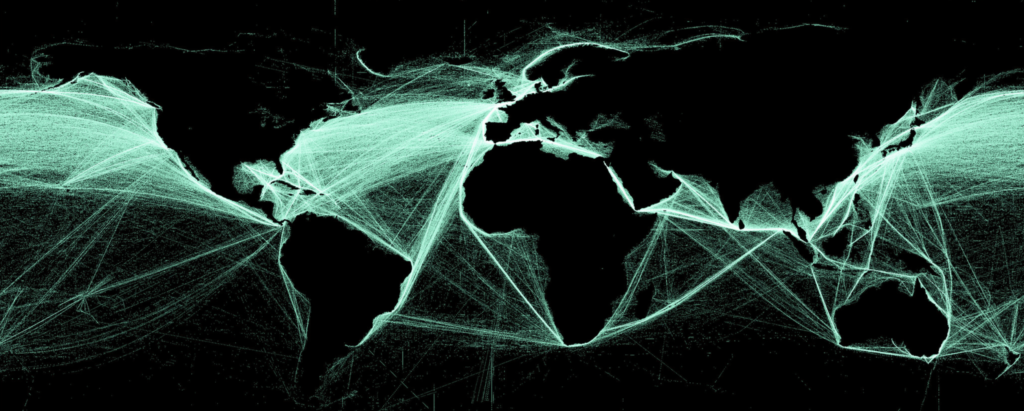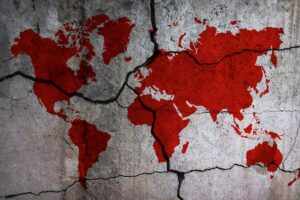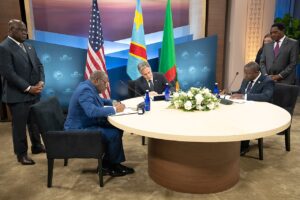Executive Summary
On February 24, 2022, Russian President Vladimir Putin’s forces launched a full-scale invasion of Ukraine. It was perhaps the first in what may have been meant to be a series of campaigns to restore the borders of Ancient Rus, which in Putin’s mind extends in the west from “Ladoga, Novgorod, and Pskov to Kyiv and Chernihiv.”1Vladimir V. Putin, “On the historical unity of Russians and Ukrainians,” Office of the President of Russia, July 12, 2021 [accessed November 30, 2022], http://en.kremlin.ru/events/president/news/66181. More than one year in the wake of the invasion, Putin’s effort is failing.
Except for the most extreme scenarios, the geopolitical winds in the wake of the war in Ukraine are not expected to shift substantially relative to prior trends — other than to accelerate Russia’s marginalization for the extent of Putin’s tenure. However, they do appear to have forced open a window for the West to further capitalize on Putin’s poorly executed aggression. Perhaps more important will be Xi’s (in)ability to revive China’s economic growth and image in the world, efforts which have, at least in the short term, been hamstrung by pandemic mismanagement at home and a combative style of diplomacy abroad.
We examine some of the implications of Putin’s failures and parallel geopolitical developments — including Chinese President Xi Jinping’s strict implementation and then rapid abandonment of a “zero-COVID” strategy — as well as longer-term developments for the future of geopolitical influence and great power competition through 2045. We do this by forecasting the Formal Bilateral Influence Capacity (FBIC) Index — an annual bilateral measure of state capacity to weaponize interdependence across economic, political, and security domains. The FBIC Index is designed to capture formal influence capacity — as in state-authorized, publicly acknowledged, largely transactional relationships, such as goods trade and arms transfers. Importantly, it is a measure of capacity, but not the willingness or ability of policymakers to leverage that capacity. Keeping these stipulations in mind, the FBIC Index has proven to be a powerful tool for tracking geopolitical influence at the macro-level, particularly in the context of great power competition.2For previous publications using the FBIC Index, see: Jonathan D. Moyer, Collin J. Meisel, Austin S. Matthews, David K. Bohl, and Mathew J. Burrows, “China-U.S. competition: Measuring global influence,” The Atlantic Council and Frederick S. Pardee Center for International Futures at the University of Denver’s Josef Korbel School of International Studies, Washington, DC, May 2021, https://www.atlanticcouncil.org/wp-content/uploads/2021/06/China-US-Competition-Report-2021.pdf; Jonathan D. Moyer, Tim Sweijs, Mathew J. Burrows, and Hugo Van Manen, “Power and influence in a globalized world,” The Atlantic Council, The Hague Centre for Strategic Studies, and Frederick S. Pardee Center for International Futures, Washington, DC, 2018, https://www.atlanticcouncil.org/in-depth-research-reports/report/power-and-influence-in-a-globalized-world/.
We forecast the FBIC Index with the International Futures (IFs) tool. IFs allows for the comparison of long-term, dynamic forecasts across alternative scenarios.3See Barry B. Hughes, International futures: Building and using global models, (London: Academic Press, 2019). The IFs tool and related tutorials are freely available here: https://korbel.du.edu/pardee/international-futures-platform. Here, these scenarios include broad representations of the world along four alternative paths: Great Power Coopetition, The Doldrums, Western Resurgence, and Pariah State.
Great Power Coopetition represents a continuation of current trends, in which the war in Ukraine is protracted but reduces in intensity while most countries in the developing world — including many democracies — remain neutral. Meanwhile, China’s rise continues, albeit more slowly than in recent decades, approaching parity with the U.S. as a global leader by 2045. China’s rise occurs despite its notable demographic challenges, which exist in all scenarios presented here, but which we do not expect to have severe impacts until mid-century,4Collin Meisel and Jonathan D. Moyer, “Preparing for China’s rapid rise and decline,” War on the Rocks, April 19, 2019, https://warontherocks.com/2019/04/preparing-for-chinas-rapid-rise-and-decline/. just past the end of our forecast horizon in this report. Elsewhere in this future, human development is expected to improve worldwide across a host of indicators through 2045, including increased average education years, increased life expectancy, and decreased poverty rates (although absolute poverty headcounts will likely increase across this period in some countries, such as Nigeria). Additionally, democracy spreads in terms of the share of the global population living under democracy, but this is less due to increased democratization than it is to population growth in already democratic countries, particularly India.
The Doldrums assumes that global growth will veer into a long recession, that the war in Ukraine stalls, and that long-term efforts by the U.S. and China to maintain or expand each country’s geopolitical influence see few gains. Along this path, decreasing capacity for domestic consumption in virtually all economies leads to a decreased demand for imports and reduced economic interconnectedness. More broadly, policymakers face increasingly difficult tradeoffs — not only between “guns and butter”-type issues but also between health care and education, for example—investments that can put the present and future well-being of a country’s people at odds. The U.S. sees a relative increase in influence capacity vis-à-vis its competitors in this scenario, but only because it loses less, with ample inward migration, geoeconomic institutions that largely favor American interests, and a strong propensity for innovation each offering the U.S. the ability to better weather The Doldrums.
Western Resurgence assumes that Western countries will avoid recession in 2023 and that Ukraine will continue to make gains in its eastern territory. Other longer-term developments — including an opening of U.S. trade policies and the crafting of expansive multilateral trade agreements — lead to a tipping of the balance of geopolitical influence in the West’s favor relative to China. If such a future were to come to pass, it would mark a revival of the post-World War II liberal international order, with the West serving as an unambiguous bastion of opportunity and a center of economic, political, and security networks for a vast majority of the globe. This would have important consequences for U.S. and European soft power — a concept not directly measured in this analysis, but which would likely manifest in increased educational and cultural exchange opportunities provided by greater-than-expected economic growth and deepening interconnectedness with Western businesses and governments.5For an exposition of this logic, see Joseph S. Nye Jr., “The changing nature of world power,” Political Science Quarterly 105, no. 2 (1990): 177–192. Rather than seeking to decouple from China, the West is able to confidently invite interdependence with all comers, secure in the knowledge that a more equitable international order remains in its favor as it further incorporates the perspectives of the Global South.
Pariah State reflects a more unfortunate path. Following Russia’s violation of a seven-decade taboo against nuclear first use, there is a further deepening of the “comprehensive strategic partnership of coordination for a new era”6This is the Chinese state media’s formal name for China’s “no limits” partnership with Russia. between China and Russia as much of the rest of the world recoils. In this world, the coming decade is characterized by volatility and radical uncertainty. International investment decreases as holders of capital shy away from risk. Interest rates rise substantially as domestic capital becomes more tightly held. Russian trade with the world outside China shrinks to a small fraction of current values. Meanwhile, trade protectionism worldwide shifts into overdrive in an attempt to both decrease dependence on foreign economies and to appease nationalistic calls to boost domestic production in advanced economies.
The various elements of these scenarios are unlikely to unfold in a manner that is mutually exclusive. Reality is, of course, often messier than we give credit.7Graham Kenny, “Strategic plans are less important than strategic planning,” Harvard Business Review, June 21, 2016, https://hbr.org/2016/06/strategic-plans-are-less-important-than-strategic-planning. Yet, by examining a few scenarios that track along broadly different trajectories, we can gain an understanding of the range of plausible trajectories along which the future can be expected to unfold while ensuring our analysis is tractable.8Olaf Helmer, “The use of expert opinion in international relations forecasting” in Nazli Choucri and Thomas W. Robinson (eds), Forecasting in international relations: Theory, methods, problems, prospects (W.H. Freeman and Company 1978): 123. Most revealing is not a single takeaway from a single scenario but the patterns that unfold across scenarios.
Taken together, our key findings across these scenarios are as follows:
- Putin’s invasion and Xi’s pandemic mismanagement have opened a narrow window of opportunity for the U.S. and its allies and partners to beat back revisionist powers’ attempts to reshape the international order. Namely, we forecast that in the next five to ten years the U.S. will be in its most advantageous relative position to consolidate and reinforce its influence capacity in countries where it currently leads competing influencers, particularly China. The U.S.’s success will be conditioned upon additional outreach through trade and a further incorporation of the Global South into global decision-making, among other factors.
- Yet, across all scenarios, forecasted Western gains are expected to slow, but not stop, China’s rise given its tremendous economic potential, especially its capacity for trade. In other words, the story here is an opportunity to lose less strategic ground to China in a relative sense than might have otherwise been the case.
- The Middle East alternates between its own and China’s sphere of influence across scenarios, suggesting that the era of U.S. dominance in the region is over. These dynamics are being driven by a substantial Chinese diplomatic presence in the region, China’s increasing demand for Middle Eastern oil, and an increasingly integrated and potentially influential Middle East.
- Over the long term, it also appears that in all scenarios, even amid a Western Resurgence, the West will only be able to compete with China for influence capacity in sub-Saharan Africa if the U.S. and European partners develop a coordinated aid strategy and develop substantial trade agreements with the region.
- Meanwhile, intra-European interdependence and influence is expected to increase markedly relative to a No War world while at the same time becoming more diffuse among European countries. In other words, we are likely to see a more equal and consolidated Europe than otherwise might have been, which could mean the long-hypothesized emergence of Europe as a cohesive geopolitical power.
- Through at least 2045, Russia is expected to maintain its own unique sphere of influence that includes Belarus, the Caucasus (excluding Georgia), and much of Central Asia. This is despite an accelerated Russian decline and projected enlargement of China’s sphere of influence, which by 2045 may comprise much of Asia, the Middle East, and Northern Africa. Thus, while China will become an increasingly crucial bilateral, if not alliance, partner for Russia, structural factors have and are expected to continue to distinguish their areas of influence.
These findings are contingent upon several factors. Over the long term, our scenarios assume that broad, longstanding patterns of development across demographic, economic, and other issue areas will experience largely continuous rather than discontinuous change. These forecasts are not extrapolations, but major discontinuities, such as the sudden widespread availability of nuclear fusion, are not implicitly factored in. (Such a change would require a direct scenario intervention.) Persistent changes, including some of their measurable second- and third-order effects, are factored in.
In the short term, our forecasts assume that Western governments will continue to attempt to meet Ukraine’s need for arms, ammunition, and aid for the duration of the conflict and amid post-conflict recovery efforts, even if that support is limited by economic stagnation, such as in The Doldrums. Future domestic political shifts could dictate otherwise. We also assume that some Western aid that was previously earmarked primarily for developing countries in sub-Saharan Africa will be redirected to Ukraine, even amid a Western Resurgence. If instead total Western, and especially U.S., foreign aid budgets increased to the point of eliminating the need for tradeoffs in order to support Ukraine, then China’s rise in geopolitical influence capacity would be further slowed.
With these findings and provisos in mind, our analysis offers the following policy recommendations:
- Across all scenarios, U.S. policymakers should seek to connect the concept of formal bilateral influence capacity and its primary components into the broader concept of integrated deterrence — a concept that combines integration of efforts across domains, regions, the spectrum of conflict, the U.S. government, and allies and partners.9White House, National security strategy (Washington, DC: White House, 2022): 22. U.S. influence capacity is a product of economic, political, and security dimensions, and it can manifest both bilaterally and through network effects with allies and partners.
- Policymakers should seek to understand where the U.S. is expected to struggle to compete via formal bilateral influence capacity and consider cultivating alternative sources of influence, such as soft power. For example, through leadership by example at home — including strengthening democratic institutions, enacting policies that seek to reduce economic inequality, and advancing social justice — the U.S. image will be enhanced abroad, generating an intangible but invaluable influence capacity in much of the developing world.
- Policymakers must also seek to leverage the U.S. capacity for innovation, which offers a decisive edge against competitors.
Additional scenario-specific policy recommendations are summarized in the table below.
Notes
- 1Vladimir V. Putin, “On the historical unity of Russians and Ukrainians,” Office of the President of Russia, July 12, 2021 [accessed November 30, 2022], http://en.kremlin.ru/events/president/news/66181.
- 2For previous publications using the FBIC Index, see: Jonathan D. Moyer, Collin J. Meisel, Austin S. Matthews, David K. Bohl, and Mathew J. Burrows, “China-U.S. competition: Measuring global influence,” The Atlantic Council and Frederick S. Pardee Center for International Futures at the University of Denver’s Josef Korbel School of International Studies, Washington, DC, May 2021, https://www.atlanticcouncil.org/wp-content/uploads/2021/06/China-US-Competition-Report-2021.pdf; Jonathan D. Moyer, Tim Sweijs, Mathew J. Burrows, and Hugo Van Manen, “Power and influence in a globalized world,” The Atlantic Council, The Hague Centre for Strategic Studies, and Frederick S. Pardee Center for International Futures, Washington, DC, 2018, https://www.atlanticcouncil.org/in-depth-research-reports/report/power-and-influence-in-a-globalized-world/.
- 3See Barry B. Hughes, International futures: Building and using global models, (London: Academic Press, 2019). The IFs tool and related tutorials are freely available here: https://korbel.du.edu/pardee/international-futures-platform.
- 4Collin Meisel and Jonathan D. Moyer, “Preparing for China’s rapid rise and decline,” War on the Rocks, April 19, 2019, https://warontherocks.com/2019/04/preparing-for-chinas-rapid-rise-and-decline/.
- 5For an exposition of this logic, see Joseph S. Nye Jr., “The changing nature of world power,” Political Science Quarterly 105, no. 2 (1990): 177–192.
- 6This is the Chinese state media’s formal name for China’s “no limits” partnership with Russia.
- 7Graham Kenny, “Strategic plans are less important than strategic planning,” Harvard Business Review, June 21, 2016, https://hbr.org/2016/06/strategic-plans-are-less-important-than-strategic-planning.
- 8Olaf Helmer, “The use of expert opinion in international relations forecasting” in Nazli Choucri and Thomas W. Robinson (eds), Forecasting in international relations: Theory, methods, problems, prospects (W.H. Freeman and Company 1978): 123.
- 9White House, National security strategy (Washington, DC: White House, 2022): 22.




